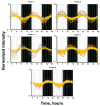Circadian variations in rat liver gene expression: relationships to drug actions
- PMID: 18562560
- PMCID: PMC2561907
- DOI: 10.1124/jpet.108.140186
Circadian variations in rat liver gene expression: relationships to drug actions
Abstract
Chronopharmacology is an important but under-explored aspect of therapeutics. Rhythmic variations in biological processes can influence drug action, including pharmacodynamic responses, due to circadian variations in the availability or functioning of drug targets. We hypothesized that global gene expression analysis can be useful in the identification of circadian-regulated genes involved in drug action. Circadian variations in gene expression in rat liver were explored using Affymetrix gene arrays. A rich time series involving animals analyzed at 18 time points within the 24-h cycle was generated. Of the more than 15,000 probe sets on these arrays, 265 exhibited oscillations with a 24-h frequency. Cluster analysis yielded five distinct circadian clusters, with approximately two thirds of the transcripts reaching maximal expression during the dark/active period of the animal. Of the 265 probe sets, 107 were identified as having potential therapeutic importance. The expression levels of clock genes were also investigated in this study. Five clock genes exhibited circadian variation in the liver, and data suggest that these genes may also be regulated by corticosteroids.
Figures









References
-
- Basuroy UK, Gerner EW. Emerging concepts in targeting the polyamine metabolic pathway in epithelial cancer chemoprevention and chemotherapy. Journal of Biochemistry. 2006;139:27–33. - PubMed
-
- Binder EB, Salyakina D, Lichtner P, Wochnik GM, Ising M, Putz B, Papiol S, Seaman S, Lucae S, Kohli MA, Nickel T, Kunzel HE, Fuchs B, Majer M, Pfennig A, Kern N, Brunner J, Modell S, Baghai T, Deiml T, Zill P, Bondy B, Rupprecht R, Messer T, Kohnlein O, Dabitz H, Bruckl T, Muller N, Pfister H, Lieb R, Mueller JC, Lohmussaar E, Strom TM, Bettecken T, Meitinger T, Uhr M, Rein T, Holsboer F, Muller-Myhsok B. Polymorphisms in FKBP5 are associated with increased recurrence of depressive episodes and rapid response to antidepressant treatment. Nature Genetics. 2004;36:1319–1325. - PubMed
Publication types
MeSH terms
Substances
Grants and funding
LinkOut - more resources
Full Text Sources
Molecular Biology Databases

